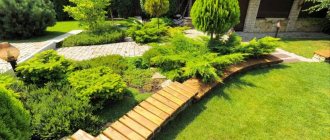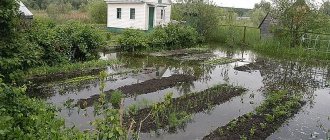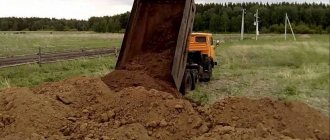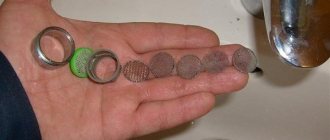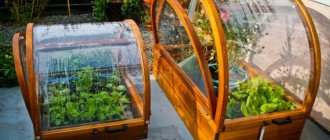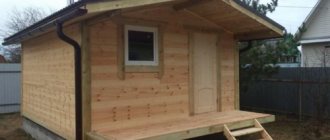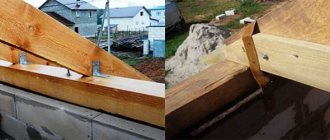A neatly decorated plot with designated areas for planting various vegetable and fruit crops, with beautiful flower beds and a smooth lawn is the dream of every gardener. But in many cases, homesteads are given to new owners in a neglected state. Despite the apparent complexity of the work ahead, you should not give up and spend money on attracting outside help. There are several simple and affordable ways to independently, without much effort, remove weeds from an overgrown area and put it in order.
Step-by-step action plan
It will be easier to master a new area if you break the process into separate tasks and then complete them one after another. Then a clear picture will immediately form in your head - what is most important, where to start, what can be left for later.
This will relieve the state of some confusion in which owners of neglected areas often find themselves.
Pre-planning will also help to avoid annoying mistakes that can complicate the life of a summer resident and add more work to him.
The development of an overgrown area can be divided into the following stages:
- Cleaning the area.
- Removing unnecessary trees and shrubs.
- Tidying up the remaining trees and bushes.
- Weed control.
- Preparing the soil for planting.
- Keeping the soil weed-free.
Conclusions about the main thing
There are several ways to drain a plot of land yourself, but if you are not ready to carry out heavy excavation work and do not have sufficient experience and knowledge, it is more effective to entrust this to specialists.
To choose the right drainage, the following factors should be taken into account:
- soil composition and permeability;
- dimensions and shape of the pit for future construction, weight of the building;
- groundwater level depending on the season (the highest value is applied);
- the possibility of seasonal floods due to melting snow and autumn precipitation;
- speed of movement and direction of groundwater.
All factors can be foreseen only after a geodetic analysis of the soil; in some cases, test drilling is used.
Cleaning the area
First you need to clear the area of household waste. These can be rags, fragments of bottles and bricks, boards, rusty pieces of iron and other objects that have no place in the beds.
Sometimes what remains from the previous owners is a real mini-dump, disguised with weeds or lightly sprinkled with earth.
However, you shouldn’t rush to throw everything away at once. Some things can be useful on the farm, especially at first. For example, boards, old buckets, large pieces of film, etc.
Now you need to walk around the area with a strong iron rake and comb out the old grass along with fallen leaves and twigs.
Dry standing stems of large weeds can be trimmed, cut with pruning shears or mowed with a sickle. All plant debris will be useful for laying a compost heap or warm beds.
How to fight vipers. Repellent
Repelling will help remove reptiles from the area. But very often they return after the threat disappears.
So, how to scare away snakes from your summer cottage?
You can play on the susceptibility of vipers to odors. Scattered mustard powder (about 100 g per hundred square meters) or beds of garlic in different places in the garden help a lot. Dispose of shed snake skins. Reptiles return to the place where they moulted.
Burning will make the area unattractive to reptiles.
Vipers are sensitive to chemicals. Scattered mothballs, fertilizers (saltpeter, amophoska, any garden herbicide), rags soaked in diesel fuel will repel reptiles.
Use sound effects. Wind chimes, bells, rattles, weather vanes - all this will create noise that reptiles do not like at all.
The use of mole repellers has a good effect. These devices generate ultrasonic waves and vibrations to which reptiles respond. Such devices can be purchased at fishing and tourism supply stores.
It will be useful for you to learn how to deal with rodents that have settled on your site.
Weed control
It will not be possible to completely get rid of weeds in an overgrown area in one season. This will require at least 2 years.
Typically, neglected areas are overgrown with perennial grasses such as gooseberry, wheatgrass, sow thistle, stinging nettle, etc. Such weeds are difficult to remove; you must immediately prepare yourself for a long and persistent fight against them.
If the area is covered with annual vegetation such as woodlice, acorn grass, white goosefoot, galinsoga and chickweed, then you can rejoice. It will be much easier to deal with them.
Without the help of chemicals, it will not be possible to quickly clear an overgrown area of weeds. This is especially true for large areas.
In a small area, it is still possible to eradicate weeds by constant mowing or plowing, but this will take a lot of time.
In addition, this will need to be done every two weeks. If you act manually, then in this way you can conquer only a small space from the virgin soil. If you hire heavy equipment, it will be very expensive.
To destroy harmful perennial weeds, it is better to use continuous herbicides based on glyphosate.
These are drugs such as Tornado, Roundup, Glyphos, etc. They spray the leaves of the weeds, and then wait 2-4 weeks until the poison reaches the roots and the plants die.
During this period, they cannot be mowed or pulled out of the ground. For the drug to work, there should be no rain for the first few hours after spraying.
Application of non-woven covering materials
If you need to free up a small piece of land and have at least a season left, you can use covering materials. The simplest and most effective are black non-woven covering materials - they are laid out on the site in the spring, choosing the most dense ones. Over the summer, the weeds will die under the geotextile, and at the end of the season it will be possible to plow the soil and apply fertilizers in order to begin processing in the spring.
Of course, the weed seeds will not disappear over the course of the year and will continue to sprout, but there will be significantly fewer of them.
You can replace geotextiles with any dense biodegradable material, for example, corrugated cardboard. It will serve the same, although it will look less presentable.
- Covering material for beds, greenhouses and greenhouses - which one is better to choose
How to choose a good covering material, and what exactly does your planting need? Let's explore the variety of colors and textures together!
If you are in a hurry and want to plant the first vegetables and berries this year, then install the frame directly on a layer of cardboard, fill it with fertile soil, brought to order or available to you, and then plant herbs, vegetables, strawberries in these ridge boxes etc. In a couple of years, the cardboard at the base of the ridge will decompose without a trace. But the covering material is not suitable for this; it will have to be removed in the fall.
Cutting down trees and bushes
First you need to assess the condition of the trees and shrubs growing on the site and decide which of them can be left and which are better to get rid of.
First of all, you should pay attention to their age, productivity, and health status.
Their location also matters - whether they obscure a large piece of land, whether they threaten buildings, or violate the interests of neighbors.
Tall trees, for example, should be no closer than 4 m from the boundaries of the adjacent area.
It should be borne in mind that in abandoned areas the trees are usually very neglected. Their restoration is a complex and long process. So sometimes it’s easier to plant new seedlings than to tidy up old plantings.
New areas often grow wild trees like pine or birch, which sometimes you want to leave for beauty. However, it is worth considering that many cultivated plants cannot develop normally near them.
It is important to remember that to remove trees, even on your own property, you may need a felling ticket, i.e., official permission for this procedure.
After cutting down trees and shrubs, stumps remain, which take up valuable space and spoil the appearance of the site. You can get rid of them in different ways:
- With the mechanical method, the stump is first dug up to expose as many roots as possible. They can also be released from the ground using a strong stream of water. Then the roots are cut off. After this, the stump is uprooted using a crowbar, a shovel or a hired bulldozer.
- With the chemical method, a fresh cut of the stump is treated with a herbicide. Its roots die and eventually decompose themselves. Such a stump will not sprout, and after 1–2 years it can be easily pulled out of the ground.
- With the biological method, the stump is not uprooted, but honey mushrooms are grown on it. To do this, several holes are made in it and pieces of mycelium brought from the forest are placed there. Then it is watered regularly, and after a few months the harvest is harvested. In a few years, the stump itself will turn into dust.
general characteristics
The shrew family (Soricidae) belongs to the order of insectivores of the mammalian class. Externally, the shrew is similar to an ordinary mouse , but has a smaller body (from 3.5 to 18 cm long, weighing from 1.2-1.5 to 100-150 grams), with soft fluffy fur of a predominantly gray color and a very long tail. She has small, blind eyes above an elongated muzzle with an elongated proboscis nose and almost invisible ears on her head.
More than 20 species live in Russia, including the ubiquitous common shrew , whose sharp teeth are colored brown due to the presence of iron in the enamel (which explains its name). The body is covered with light brown hair and reaches no more than 8 cm in length and weighs 4-16 grams.
Common shrew (pictured)
From April to September, the female breeds 2-3 offspring, numbering from 4 to 14 cubs, bearing them for 13-28 days. 4 weeks after birth, the animals are ready for independent life, the duration of which is about 18 months.
When a mother shrew moves with her offspring, you can see them holding onto each other's tails with their teeth, as if they were playing "train"
Improvement of trees and bushes
It’s quite easy to tidy up neglected shrubs. First you need to get rid of all dry and damaged branches.
Then, following the pruning rules for each crop, shorten or completely remove some of the shoots. All this can be done in one season.
Many types of shrubs can be rejuvenated by simply cutting them back to 2/3 of their height or even more. This can be done with gooseberries, honeysuckle, currants, shadberry, and viburnum. All bushes must be well fed.
Neglected trees cannot be completely restored in one season. At first, it is enough to carry out sanitary pruning. It can be done at any time.
The main thing is that the air temperature is positive. Which branches should be deleted first:
- dry or injured;
- damaged by diseases or pests;
- hanging down to the ground;
- intertwined with each other;
- potentially dangerous to buildings and people.
More than three large branches cannot be removed at one time, as the tree will receive too many wounds and will not be able to cope with them. In the second year it is already possible to thin out and shape the crown. But overgrowth shoots can be cut out at any time.
Very often, trees on an abandoned site are affected by diseases and pests, so they need to be treated with suitable chemicals.
Over several years without proper care, the soil under the trees has become very depleted, so it needs to be well fertilized. Simultaneously with fertilizing, it is useful to shallowly loosen the soil under the crown and form a tree trunk circle.
How to get rid of grass snakes in your summer cottage using folk remedies. Prevention
Measures aimed at preventing snakes from entering the area are very simple. By their nature, snakes and other snakes prefer quiet, damp and secluded places, so they need to create completely opposite conditions.
Attention!
To do this, it is necessary to conduct a general inspection of the site, remove the remains of building materials, old trees and stumps, and drain the wetlands. It will also be useful for any gardener to learn how to defeat woodlice in the garden.
Such revisions must be constant, otherwise a new family will willingly settle in the place of a new accumulation of garbage. It is better to keep the compost pit closed, because it is an ideal environment for laying snake eggs. It should be noted that snakes guard their offspring very carefully, so even an accidental approach is regarded as an attack.
That is why it is better to store compost away from residential buildings, playgrounds and utility rooms. If there is a possibility that a snake lives there, it is best to approach in rubber boots and with a suitable “weapon” at the ready.
If you notice remains of a snake or old skin on the area, you need to get rid of it immediately. According to signs, the snake will definitely return to the place where it moulted, and the corpse of an ally means that the place is free, so new newcomers will willingly inhabit it.
Maintaining cleanliness is not everything, because snakes can live in dense thickets of raspberries or blackberries, and also build a nest in the tall grass on the outskirts of the site. Regular weeding of bushes and mowing the grass will help solve this problem. If there are abandoned areas or a forest nearby, you will have to act on an even larger scale.
To do this, you need to surround your site with a high fence, in which no cracks or gaps are allowed. It is best to place the fence on a brick or stone foundation, the base of which should be at least half a meter. Regular inspection, as well as treating the fence with repellent chemicals will help prevent snakes from getting inside.
You can also use wind rattles and ultrasonic devices, the noise from which will probably not be liked by creeping reptiles.
To summarize, we can highlight the basic rules of prevention:
- Avoid accumulation of garbage, remove old trees and stumps in a timely manner.
- Take care of a high, sealed fence.
- Move the compost pit away from the house and make it closed.
- Regularly mow the grass and thin out the bushes.
- Plant spicy and fragrant herbs around the perimeter of the site: garlic, mustard and mint will provide natural protection from aliens.
Measures aimed at protecting against snakes are, in principle, no different from the work plan of any owner, because they involve additional thermal insulation of premises and basic sanitary rules.
Important!
In addition, such methods will keep the area well-groomed and beautiful. In addition to improving the territory, it is also necessary to take care to prevent reptiles from entering residential buildings and sheds.
A good repeller would be spread out rags with odorous impregnations, but this option has an increased risk of fire. Spices scattered around the perimeter of buildings, as well as wind bells, are also suitable. You should also check the walls and foundation for cracks to prevent snakes from getting inside.
It is quite easy to repel snakes from the site, and modern devices and folk remedies will come to the rescue. Snakes usually settle in places where they can hunt without problems, so it would be useful to simultaneously fight rodents, toads and frogs. Without prey, the area will become unattractive for snakes, so they will leave the garden on their own.
The mechanical method of exterminating a snake usually turns out to be less effective, because the harmless snake can be replaced by a poisonous viper. That is why it is better to scare away reptiles, regardless of breed, and how to do this most effectively is described below.
Tillage
Only after the weeds treated with the herbicide die can you start digging the soil. Before doing this, it makes sense to walk around the area and collect stones, otherwise they will dull the working tool.
In an overgrown area, weeds leave behind turf - densely intertwined plant roots. It is impossible to cope with them with a shovel or hand cultivator.
In order to properly prepare such soil for planting, it is recommended to hire a tractor for this at least once. What are the options for cultivating land using agricultural machinery:
- First, harrow the soil with heavy disc harrows to cut the turf. After this, plow it and wrap the layer. All these terms are known to the tractor driver; he will understand what is required of him. Disking before plowing is necessary if the turf layer is very thick, and especially if it is formed by wheatgrass roots.
- First, plow the soil deeply, then cultivate it a couple of times, preferably lengthwise and crosswise. If possible, it would be a good idea to remove weed roots from the soil immediately after plowing. If this was not possible, then you will have to clean the cultivator of them while using it.
If you don’t want to hire a tractor, you can dig up the area yourself with a middle-class walk-behind tractor, always deep and turning over the turf.
True, in this case it will be almost impossible to pick out weed roots from the ground, since the walk-behind tractor will break them into small pieces.
It is impossible to cultivate the soil after many years of thickets of weeds with an electric cultivator. First it needs to be plowed with a tractor.
After digging, the soil must be leveled. For this purpose, disking or cultivation is carried out over a large area. In a small area, this task can be done manually - cut off the mounds with a shovel, fill in the holes, and then go over with a rake.
Despite popular belief, land that has not been cultivated for a long time does not always produce a good harvest. Firstly, it is not necessarily fertile. Secondly, for several years, harmful substances released by weed roots accumulated in it.
These toxins inhibit other plants, and as a result, the harvest is often poor in the first year. Organic fertilizers help decompose these harmful substances and also enrich the soil. So it makes sense to add organic matter at the same time as digging.
Advice from experienced gardeners
To make work on removing weeds from an overgrown area more effective, you should use the advice of experienced gardeners:
- Avoid using fresh manure. This organic fertilizer contains a large number of weed seeds. If the composition is allowed to rot for a year, it will become very hot during decomposition, and all weed seeds will die.
- Weeds love emptiness. It is necessary to plant all the free space of the site with cultivated plants, then weeds will have nowhere to grow.
- Compaction of plantings. Plants should grow densely, but not crowded.
- Regular pruning of the above-ground parts of weeds. The roots of pest plants will use up their entire supply of nutrients and die.
- Processing beds with a pitchfork. When working with a shovel, you can cut the large rhizome of the weed, and from all its parts numerous shoots will soon appear.
- Weeding by hand. Many plant pests grow from the top of the root. If you cut it down while working with a hoe, a branched bush with several stems and a large number of seeds will grow from this place.
- Application of drip irrigation. Weeds also need moisture. If you water cultivated plants carefully at the very roots, so that the water does not spill over the entire area, the weeds will dry out. For the same reason, it is not recommended to use a hose to water plants.
PLOWING VIRGIN GROUND – FIRST EXPERIENCE
I decided not to panic and not to rush in my actions. I thought that over the summer I would plow it all over with a tractor so that the upturned roots would dry out and then they could be picked out without much effort. And the raised layers of compacted earth would have gotten wet over the winter, and I would have loosened them next year. But life dictated its own rules. The summer turned out to be very hot and dry, and therefore I did not have the opportunity to burn all the trash, as well as the cut wild raspberry branches. All this had to be piled up in a huge pile in the middle of the plot to free up space for plowing.
Folk remedies for snakes. Homemade and Natural Snake Repellents
You can scare away a snake with the help of folk repellents, which include fox urine, smoking smoke, diesel fuel and a mixture of mothballs with cat litter, lime and pepper-based sprays. But some scientists argue that all these remedies are ineffective. And experts also call diesel fuel very harmful to the environment: your green spaces and beneficial insects in the garden will not be happy with it. Although some researchers from America talk about its restrictive effect on rattlesnakes.
What about repellents made from natural essential oils? Such mixtures are common for controlling parasites in the garden, but nothing effective has yet been created against snakes.
How effective are snake repellents?
Let's start with the facts: Some scientists radically claim that all chemical repellents are ineffective against snakes. Perhaps this is due to the olfactory system of reptiles, because snakes sense odors using a forked tongue. This means that scents do not scare them away from a distance! And even with physical contact, she will feel it only if she touches the ground with her tongue.
What you definitely shouldn’t buy are products that position themselves as universal: like they are against spiders, and against snakes, and against rats... Many biologists are sure that these drugs are the worst. And don’t consider options with ultrasonic repellers. After all, snakes don’t have ears!
But still, popular snake repellers - powders and granules based on sulfur and naphthalene - aroused some interest in us. Experts are divided on them, so let's consider them as potential snake repellers! And a little later we will find out what ordinary users think about such repellents.
Description of pests
Controlling rodents is usually quite difficult, but necessary, because under favorable conditions animals reproduce easily and quickly. Let's find out how these mice differ, what are their characteristics and habits in order to effectively deal with them.
House mouse
The animal Mus musculus or house mouse, which can be found in your home, garage, basement, is characterized by strong synanthropy. Synanthropic organisms are animals, plants, and microorganisms associated with humans. So, this rodent is found wherever people live. Its presence has even been confirmed at research stations in Antarctica.
House mice have many natural enemies that occupy higher positions in the food chain. Many predators feed on rodents - cats, wild dogs, weasels, foxes, birds, snakes. Therefore, in the wild, mice usually live 5-6 months. In the laboratory or as a pet they can live up to 2 years.
A female house mouse reaches reproductive capacity in 2 months. Then every 3-4 weeks the mouse is able to give birth to a dozen children. More than 100 cubs can be born in a year! Therefore, if you notice a rodent in the house, there will soon be many more of them.
Mice are nocturnal animals and go out in search of food after dark. They are omnivores, love to eat fruits, plant grains, meat, and dairy products. They even eat their own excrement, obtaining nutrients produced by bacteria living in their intestines.
They have poor eyesight, but good hearing and smell. Mice use their whiskers to sense temperature changes and surface textures. Rodents live in complex burrows with long entrances and multiple escape routes; they keep the burrows clean - they have separate places for storing food, sleeping, and toileting.
To get rid of mice, you should familiarize yourself with information about their characteristic behavior. Then you will be able to take adequate actions to prevent the rodent from entering your house or warehouse.
Features of behavior:
- House mice are very curious creatures. Every day they explore new territories in search of food sources. It is worth taking care to block any possible ways for rodents to enter the house. It is necessary to seal the holes with silicone or cement mortar. Additional protection is to store food in the pantry or basement in carefully closed containers.
- The animal is looking for warm places. The assault on houses or warehouses occurs from October to February, when rodents are looking for premises where they can shelter from the cold, get food and water. When the temperature drops by several degrees, they take refuge in basements, sheds, houses; rodents may also appear in a city apartment.
- Every year it is necessary to properly prepare for the upcoming cold weather by conducting a thorough inspection in the fall of the premises most susceptible to unwanted visits from rodents.
- Greed. The mouse eats 15-20 times a day. She makes a burrow close to food sources (up to 8 m away) for easy access. At night, the animal moves between different feeding points, taking only 0.15 g of food from each point. To track an animal, you need to check in which places there are traces of food (for example, a specific smell), then look for holes nearby.
- Loves to take a bite and throw it away. A mouse's teeth grow throughout its life. To wear down the teeth to a manageable size, the animal must continually bite and chew on objects. Victims of biting become electrical wires, which can cause a fire. Therefore, it is important to ensure that electrical systems are properly protected. If you suspect the presence of rodents near electrical equipment, you need to start scaring them away as soon as possible. Electromagnetic repellers help with this.
Identifying a potential rodent infestation is much easier than trying to find an actual mouse. Look for the following signs:
- Scratching sounds: These can be heard at night when mice are most active. Listen for sounds between partitions, under floorboards, in false ceilings, basements, and attics.
- Droppings: Mice leave small, dark droppings, especially along walls or in high-traffic areas such as countertops, cabinets, shelves, and under the sink.
- A peculiar odor: mice leave behind a trail of ammonia odor, which is felt especially strongly in confined spaces (closets).
- Mice need to chew on wood, plastic, cables, and other hard materials to keep incisor growth under control. Gnawing can even cause a house fire if mice chew on electrical cables.
- Nests. Rodents build nests from newspapers and fabrics. The nests are usually hidden, for example behind a refrigerator.
- Traces of sebum (spots, streaks) arise due to the fact that mouse fur constantly rubs against walls, floors, and baseboards on popular routes. You may notice dark stripes around holes and corners.
- Paw and tail prints can appear in dusty places, such as unused attics and basements.
- Rodents usually live in basements and attics; it is worth carefully inspecting these rooms to determine whether there are mice or other pests.
Mice can spread up to 200 different pathogens and parasites. They contaminate the surface and food with excrement, excreting it 40-100 times per day. It’s unlikely that anyone would want to find a hole in their favorite sweater, carpet or wiring. Therefore, it is worth taking quick and effective action to combat rodents.
Red vole
Small rodents, bank voles (lat. Myodes glareolus) from the family Hamsters (lat. Cricetidae) cause enormous damage. The vole lives in meadows, wastelands, gardens, and greenhouses. She has a stocky body, a short head, and a blunt muzzle. The vole lives 2-4 months, often in colonies. The female gives birth 6-7 times, 5-10 cubs per litter. Males and females care for their own and other people's offspring, so the death of the parents does not entail the death of the cubs. The vole feeds within a radius of 10-15 m around the burrow. She does not fall into winter sleep; in winter she continues to dig tunnels in the ground, sometimes moving into wooden outbuildings. This is the most common and dangerous pest among rodents.
Voles can damage:
- rhizomatous plants (carrots, parsley);
- vegetables; fruits, flower bulbs;
- plant roots;
- bark of trees, especially young ones.
How does a vole differ from a house mouse?
- fur color - the vole has reddish-brown fur, hence its name - bank vole, house mice are gray-brown;
- the vole is smaller in size - 15 cm long (including the tail and body itself: 10 cm), weighing 20 g;
- more often found in the ground, not in the basement, house;
- has characteristic black large eyes and sharp teeth, thanks to which it gnaws through twigs, roots, and bark;
- distinctive feature is a two-color tail;
- shorter tail and paws than the house mouse.
Voles come out in the evening and at night. They will not damage basements and only feed in the garden. Some people confuse the damage caused by voles with the destruction caused by moles. Unlike moles, voles do not create mounds. This is the easiest way to determine who has settled in the garden - voles or moles. Voles dig tunnels with a diameter of 5 cm. The entrances to the burrows are located nearby. They gnaw plants from below, causing them to quickly wither.
Useful waste paper
This very original method will be effective if you carefully follow the instructions. To make it a reality, you will need rotted manure (you can use chicken manure, compost or humus). This composition must be evenly distributed over the entire area of the developed area and covered on top with black and white newspaper 5-7 layers thick. If you find this difficult, you can replace the newspaper with thick cardboard. Compost mixed with manure is poured onto the paper layer on top.
The advantage of this method is that you can make holes in newspapers in which you can plant any crops grown through seedlings. This is perfect for those who don’t want to wait a long time, being content with only potatoes and cabbage. At the end of the season, in addition to an excellent harvest of the crops you grow, you will also receive a clean area with soil enriched with vitamins and microelements.
